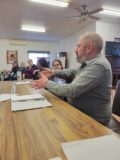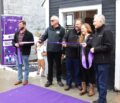Headline News
Safe consumption site being planned for North Hastings
May 25, 2021
By Nate Smelle
A growing team of community partners and harm reduction advocates gathered online on May 11 to discuss their plan to bring a safe consumption site to North Hastings. With the the local death toll from the opioid epidemic climbing sharply during the pandemic the community’s need for a safe space for people who use substances has never been greater.
As a physician with the Bancroft Community Family Health Team, and the clinical lead of the opiate management group, Dr. Ashley White is one of the local health-care professionals spearheading the Safe Use Hastings campaign. Having worked in addiction services for more than 15 years across Canada and around the world, she has experienced firsthand how this public health crisis has worsened in North Hastings amid the global COVID-19 pandemic.
Providing a glimpse of the tragedy she has witnessed on the front-lines; and a reminder of the current severity of this preventable epidemic, Dr. White said, “I don’t think people necessarily realize how many people have died. In the past year, we’ve lost a dozen young people to overdoses. We lost 12 people to COVID-19 in the year, we’d be talking about it, because we’ve said that we believe things about the value of some people. This work is motivated by the fact that we all have a place here.”
Lisa Fiorotto-Bickert has been working alongside Dr. White as the lead advocate for the local safe consumption site. Explaining what motivated the Safe Use Hastings group to work together on bringing a safe consumption site to North Hastings, she said, “We are here for science, compassion, safety, better communities, better economies, better lives.”
Fiorotto-Bickert explained further how the Safe Use Hastings group became involved with the North Hastings Community Trust’s harm reduction plan, and eventually took the reins on their application to establish a safe consumption site in the area. Shortly after the Trust initially filed the application in 2019, she said the pandemic hit and the organization had to shift its attention to the housing crisis. While anticipating a response from the federal government to their application, Fiorotto-Bickert said, “They had to pivot over to housing and then they didn’t know what they were going to do, so we stepped in… The pandemic has brought out a massive increase of overdose deaths because of fentanyl-laced drugs. The safe injection site’s urgency has therefore increased in a huge way. The time is now.”
In order to begin operating the space, Safe Use Hastings must apply to Health Canada for an exemption from the Controlled Drugs and Substance Act. While there are several different types of safe consumption sites to model the North Hastings site after, the group plans to operate a mobile safe space for people to use substances safely. The group is currently campaigning to raise $35,000 to purchase an RV that they plan to use for the space. The Safe Use Hastings site will provide addictions treatment services, harm reduction, and peer support. Fiorotto-Bickert said anyone interested in supporting the initiative can make a donation online at: https://gofund.me/05ba25ef.
According to Dr. White, every supervised consumption site currently operating has been started by people who use drugs. Having worked closely with people dealing with addictions throughout her career, she said they are sick of people dying, sick of not being treated like people, and sick of having lesser care, because of the kind of disease they have. Recognizing that this activity is happening in the community, Dr. White said a safe consumption site will help people who use substances live much healthier, safer lives. As legally sanctioned facilities, she said supervised injection sites help reduce health and public order issues that can come with the injection of drugs that are currently illegal.
“I like to have the conversation around drugs that are currently illegal, because the legal framework around drug use is actually part of the problem,” Dr. White said. “Supervised injection sites enable the consumption of drugs the people already have, so they bring the drugs with them. They are able to use in a place that is hygienic, that is not full of anxiety. And, the way that the they prepare their drugs, and the way that they use them is far less stressful. So it is done more safely, and it is done with a lower risk.”
Expanding on the risks people expose themselves to when they do not have a safe space to use, Dr. White continued, “So, if you are injecting in an alley, you don’t know who is going to come around the corner. You don’t know if you’re going to be arrested. You’re going to be fast. The lighting is not good, you’re not going to be able to see very well, and who knows what you were going to hit. Especially if you already have veins that are a little bit difficult to use. You may end up with an increased risk of abscesses, increased risk of transmission of blood-borne illnesses; and, you may be more likely to use un-sterile equipment, which is a high risk.”
Although there are many factors to consider in addressing this crisis, Dr. White said it is important to look at this common scenario for substance users from a “purely economic perspective,” to consider the costly implications for the health-care system caused by putting people through such “torture.”
“They’re huge!” declared Dr. White.
“Every case of HIV is half a million dollars. Every abscess in a person who is otherwise healthy, and people with addictions are generally otherwise healthy. These are people who are experiencing side effects of our legal framework, more so than they are experiencing necessarily the side of effects of the addiction itself.”
On top of creating opportunities for safer drug use, Dr. White pointed out how supervised injection sites also increase uptake of health-care use in a population that does not typically trust, or access health-care unless they are in “really bad” shape. Acknowledging how costly Hepatitis C and HIV treatments are on the system; and how life-altering these diagnoses are for the patient, she said many individuals with these illnesses have a tendency to give up on fighting their addictions.
If someone has Hep-C, Dr. White said it is far more likely for them to contract HIV, because co-infections make people very vulnerable. A safe consumption site would help cut down the costs on the health-care system created by wound care, and abscesses that may have otherwise ended up in the emergency room. Not only would a safe consumption site allow these afflictions to be treated earlier, she said it would also help prevent the spread of blood-borne diseases. In addition, because people who use drugs alone are at a higher risk, Dr. White said it would also save lives by allowing for earlier identification of overdoses.
“The issue is that a lot of people that use drugs are not connected to doctors,” explained Dr. White.
“So, figuring out who is doing what, means we then have an opportunity to talk about it. Like I said before, the legal framework is part of the problem. We have a legal problem as much as we have a medical problem.”
One of the goals of the initiative, Dr. White said, is to ensure that each patient they see has a primary health-care provider. It is at this point, she said, they can begin to have conversations about what type of safe supply best suits the patient’s needs.
Because for some people the right safe supply is methadone, and for others it might be Naloxone, or something else, she indicated that they first need to establish this physician to patient relationship before they know what the best treatment is for them. While sometimes the legal framework of the system prevents her from treating a patient with the best suited form of treatment, she said this framework is starting to change.
“The data is changing, and the evidence is evolving,” said Dr. White.
“We are going to get to a place where treating addiction looks very different than it does right now. And it’s hard to be patient when people are dying. When we talk about how society should deal with addiction, we have four pillars. We have prevention, we have treatment, we have harm reduction, and, we have enforcement. And we are moving all of these… This is a way to prevent people from dying, right now; and, for building different kinds of relationships with people who use drugs.”
Recognizing that there is still a lot of work to do, Dr. White said once they get the site started it won’t take much to provide the safe space and care it will offer the community. To learn more about Safe Use Hastings plans to bring a safe consumption site to North Hastings; and to get involved with supporting the project visit them online at: www.safeusehastings.com. The group plans to host their next meeting online on Tuesday, June 8 from 7 p.m. until 8 p.m. A link to access the meeting can also be found on their website.


















